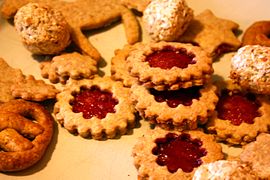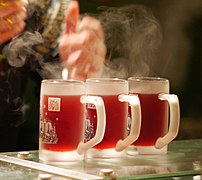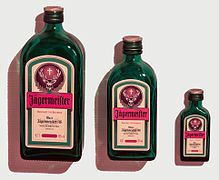German cuisine
| Part of a series on the |
| Culture of Germany |
|---|
 |
| Festivals |
| Music |
The cuisine of Germany consists of many different local or regional cuisines, reflecting the country's federal history. Germany itself is part of the larger cultural region of Central Europe, sharing many culinary traditions with neighbouring countries such as Poland and the Czech Republic (and Slovakia as well). In Northern Europe, in Denmark more specifically, the traditional Danish cuisine had also been influenced by German cuisine in the past, hence several dishes being common between the two countries (e.g. potato salad).
At the same time, the German cuisine also shares many similar characteristics with the Western European cuisine, as is reflected by some common traditional dishes served in the Low Countries (i.e. Netherlands, Belgium, and, most notably, Luxembourg). Southern German regions, such as Bavaria and Swabia, share dishes with Austrian cuisine and parts of Swiss cuisine as well.[1] The German cuisine has also influenced other European cuisines from Central-Eastern Europe such as those of Hungary or Romania, both countries sharing past and current German heritage in general, through their ethnic German minorities (see also, for example in this regard, the Transylvanian Saxon cuisine).
Furthermore, the
Hot foods
Meat




The average annual meat consumption is 59.7 kg (132 lb) per person. The most common varieties are pork, poultry, and beef. Other varieties of meat are widely available, but are considered to be insignificant.
Meat is usually braised; fried dishes also exist, but these recipes usually originate from France and Austria. Several cooking methods used to soften tough cuts have evolved into national specialties, including Sauerbraten (sour roast), involving marinating beef, horse meat or venison in a vinegar or wine vinegar mixture over several days.
A long tradition of sausage-making exists in Germany; more than 1,500 different types of sausage (
Different types of sausages include also:
Fish


Of saltwater fish, whitefish such as
Today, many sea fish, such as fresh herring,
Vegetables
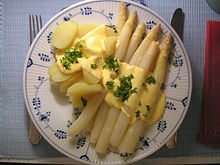
Vegetables are often used in stews or vegetable soups, but are also served as side dishes. Carrots,[17] cauliflower,[18][19] turnips,[20] spinach,[21] peas,[22] beans, broccoli and many types of cabbage are very common.[19][23] Fried onions are a common addition to many meat dishes throughout the country. Circa 1900, carrots were sometimes roasted in water, with the broth used in place of coffee.[24]
Asparagus is a popular seasonal side or main dish with a yearly per-capita consumption of 1.5 kg (3.3 lb).[25] The white variety is especially popular in Germany and more common than green asparagus.[26][27] Restaurants will sometimes devote an entire menu to nothing but white asparagus when it is in season.[28] Spargel season (German: Spargelzeit or Spargelsaison) traditionally begins in mid-April and ends on St. John's Day (24 June).[29][30]
Structure of meals
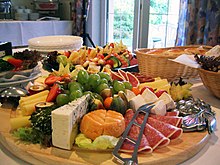
Traditionally, the main meal of the day has been lunch (Mittagessen, pronounced [ˈmɪtaːkˌʔɛsn̩] ⓘ), eaten around noon.[34] Dinner (Abendessen, pronounced [ˈaːbn̩tˌʔɛsn̩] ⓘ, or Abendbrot) was always a smaller meal, often consisting only of a variety of breads, meat or sausages, cheese and some kind of vegetables, similar to breakfast, or possibly sandwiches. Smaller meals added during the day bear names such as Vesper (in the south), Brotzeit (bread time, also in the south), Kaffee und Kuchen (ⓘ, literally for "coffee and cake"), or Kaffeetrinken. It is a very German custom and comparable with the English five-o'clock tea. It takes time between lunch and dinner, often on Sundays with the entire family.
However, in Germany, as in other parts of Europe, dining habits have changed over the last 50 years. Today, many people eat only a small meal in the middle of the day at work, often also a second breakfast, and enjoy a hot dinner in the evening at home with the whole family.[35]
For others, the traditional way of eating is still rather common, not only in rural areas. Breakfast is still very popular and may be elaborate and extended on weekends, with friends invited as guests; the same holds for coffee and cake. Since the 1990s, the Sunday brunch has also become common, especially in city cafés.
Side dishes

Besides noodles, potatoes are common.[37] Potatoes entered the German cuisine in the late 17th century, and were almost ubiquitous in the 19th century and since. They most often are boiled (in salt water, Salzkartoffeln), but mashed (Kartoffelpüree or Kartoffelbrei) and pan-roasted potatoes (Bratkartoffeln) also are traditional. French fries, called Pommes frites, Pommes (spoken as "Pom fritz" or, respectively, "Pommès", deviating from the French pronunciation which would be "Pom freet" or "Pom") or regionally as Fritten in German, are a common style of fried potatoes; they are traditionally offered with either ketchup or mayonnaise, or, as Pommes rot/weiß (lit. fries red/white), with both.
Also common are dumplings[36][38] (including Klöße as the term in the north or Knödel as the term in the south) and in southern Germany potato noodles, including Schupfnudeln, which are similar to Italian gnocchi.
Spices and condiments

With the exception of mustard, horseradish, and hot paprika, German dishes are rarely hot and spicy.
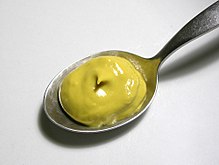
Horseradish is commonly used as a condiment either on its own served as a paste, enriched with cream (Sahnemeerrettich), or combined with mustard.[45] In some regions of Germany, it is used with meats and sausages where mustard would otherwise be used. Its use in Germany has been documented to the 16th century, when it was used as medicine, and as a food, whereby its leaves were consumed as a vegetable.[46]
Garlic has never played a large role in traditional German cuisine,[47] but has risen in popularity in recent decades due to the influence of French, Italian, Spanish, Portuguese, Greek, and Turkish cuisines. Ramson, a rediscovered herb from earlier centuries, has become quite popular again since the 1990s.
Desserts
A wide variety of
German
A popular dessert in northern Germany is
Ice cream and sorbets are also very popular.[58] Italian-run ice cream parlours were the first large wave of foreign-run eateries in Germany, which began around the mid-1850s, becoming widespread in the 1920s.[59] Spaghettieis, which resembles spaghetti, tomato sauce, and ground cheese on a plate, originated in Germany and is a popular ice cream dessert.[60]
Holidays
On the Christmas Days following Christmas Eve, roast goose is a staple of Christmas Day meals.[61][62] It is sometimes replaced with European carp,[63] particularly in Southern areas. The carp is cut into pieces, coated in breadcrumbs and fried in fat. Common side dishes are potato salad, cucumber salad or potatoes.
-
Chocolate Easter Bunny
-
Oktoberfest Gingerbread
-
Roast Christmas goose
-
Christmas cookies
-
New Year Sekt
-
Mulled wine (German: Glühwein)
Apart from Christmas, nearly all other Christian holidays and seasons have special dishes associated with them, varying regionally and by denomination. The Easter season, for instance, is typically associated with painted
Bread
Bread (Brot) is a significant part of German cuisine, with the largest bread diversity in the world.[64] Around 3000 types of breads[65] and 1,200 different types of pastries and rolls[66] are produced in about 13,000 bakeries.[67]
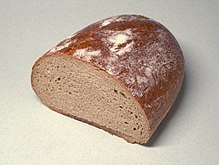
Bread is served usually for breakfast (often replaced by bread rolls) and in the evening as (open) sandwiches, but rarely as a side dish for the main meal (popular, for example, with

Regarding
Among Germany's most popular breads are spelt (Dinkelbrot), rye (Roggenbrot), rye-wheat (Roggenmischbrot), wheat-rye (Weizenmischbrot), wheat (Weißbrot), toast (Toastbrot), whole-grain (Vollkornbrot), wheat-rye-oats with sesame or linseed (Mehrkornbrot), sunflower seeds in dark rye bread (Sonnenblumenkernbrot), pumpkin seeds in dark rye bread (Kürbiskernbrot), potato bread (Kartoffelbrot) and roasted onions in light wheat-rye bread (Zwiebelbrot).
Bread rolls

Bread rolls, known in Germany as Brötchen,[72] which is a diminutive of Brot, with regional linguistic varieties being Semmel (in South Germany), Schrippe (especially in Berlin), Rundstück (in the North and Hamburg) or Wecken, Weck, Weckle, Weckli and Weckla (in Baden-Württemberg, Switzerland, parts of Southern Hesse and northern Bavaria), are common in German cuisine.[73] A typical serving is a roll cut in half, and spread with butter or margarine.[74] Cheese, honey, jam, Nutella, cold cuts such as ham,[74] fish, or preserves are then placed between the two halves, or on each half separately, known as a belegtes Brötchen.
Rolls are also used for snacks, or as a hotdog-style roll for
Franzbrötchen, which originated in the area of Hamburg, is a small, sweet pastry roll baked with butter and cinnamon.[75]
Beverages
Alcoholic drinks


Since a beer tax law was changed in 1993, many breweries served this trend of mixing beer with other drinks by selling bottles of pre-mixed beverages. Examples are Bibob (by
Cider is also popular in Germany. It is called Most or Ebbelwoi. In Hessen, people drink it from a traditional type of pitcher called a Bembel.
Wine is also popular throughout the country. German wine comes predominantly from the areas along the upper and middle Rhine and its tributaries. Riesling and Silvaner are among the best-known varieties of white wine, while Spätburgunder and Dornfelder are important German red wines. The sweet German wines sold in English-speaking countries seem mostly to cater to the foreign market, as they are rare in Germany.
All cold drinks in bars and restaurants are sold in glasses with a calibration mark (Eichstrich)[77] that is frequently checked by the Eichamt (~ Bureau of Weights and Measures) to ensure the guest is getting as much as is offered in the menu.
Non-alcoholic drinks

Popular soft drinks include Schorle, juice or wine mixed with sparkling mineral water, with Apfelschorle being popular all over Germany,[81] and Spezi, made with cola and an orange-flavored drink such as Fanta. Germans are unique among their neighbors in preferring bottled, carbonated mineral water, either plain (Sprudel) or flavored (usually lemon) to noncarbonated ones.
Drinking water of excellent quality is available everywhere and at any time in Germany. Water provided by the public water utilities can be had without hesitation directly from the tap. Usually, no chlorine is added. Drinking water is controlled by state authority to ensure it is potable. Regulations are even stricter than those for bottled water (see Trinkwasserverordnung).
Regional cuisine
German regional cuisine can be divided into many varieties such as Bavarian cuisine (southern Germany) or Thuringian (central Germany) and Lower Saxon cuisine (northern Germany).[85]
Baden-Württemberg
This southwest German state is divided into Baden and Swabia, whose cuisines are slightly different. Due to Baden's physiogeographical situation in the
Bavaria

The Bavarian dukes, especially the
A characteristic Bavarian cuisine was further developed by both groups, with a distinct similarity to Franconian and Swabian cuisine. A Bavarian speciality is the Brotzeit, a savoury snack, which would originally be eaten between breakfast and lunch.
Bavaria is a part of Southeastern Germany, including the city of Munich and spreading to Germany's borders with Austria and the Czech Republic. The region is located at higher elevations, and is known for yielding beet and potato crops and also for the production of fine beers.
Franconia

Franconia, a major region consisting roughly of the northern half of
Hamburg

Due to its centuries-old history as a harbour town, the traditional cuisine of
International trade made
Hessen

Typical for Hessen are Frankfurter Rippchen, a spiked pork cutlet, which is often served with sauerkraut and mashed potatoes.
Also from Hessen comes the Frankfurt green sauce ("Grüne Sauce"). It is a cold sauce based on sour cream with the local herbs borage, chervil, cress, parsley, pimpinelle, sorrel and chives. The start of the season is traditionally Maundy Thursday ("Gründonnerstag"; which means "green Thursday" in German). Green sauce is mostly served with potatoes and boiled eggs.
One of the best-known specialties from Hesse is the Frankfurter Kranz, a buttercream cake whose shape is reminiscent of a crown, a reminiscence of Frankfurt as the historical coronation city of the German emperors.
Palatinate/Pfalz

The kitchen of the Palatinate, a region in the south of Rhineland-Palatinate, is largely determined by regional dishes. They are sometimes quite hearty, not least because the cooking recipes were sometimes developed in times of need or in the context of heavy physical work.
Probably the best-known dish is the Pfälzer Saumagen, a pork stomach stuffed with sausage meat, bacon, potatoes and spices. The dish became famous as the favorite meal of Federal Chancellor Helmut Kohl, who especially enjoyed serving this dish at state receptions.
In the Palatinate, the salty-crust Dampfnudel is a traditional main dish, either with sweet side dishes (for example wine sauce, custard or boiled fruit such as plums, pears or the like) or with salty side dishes (for example potato soup, vegetable soups, goulash or pork) is eaten.
Thuringia

One-third of Thuringia is covered in forest, and is considered to be one of the best game-hunting regions in Germany. Anyone holding a valid hunting license
The most famous foods from Thuringia are
(minced pork).Saxony

In general the cuisine is very hearty and features many peculiarities of central Germany such as a great variety of
The rich history of the region did and still does influence the cuisine. In the blossoming and growing cities of Dresden and Leipzig an extravagant style of cuisine is cherished (one may only think of the crab as an ingredient in the famous Leipziger Allerlei). In other, impoverished regions where the people had to work hard to yield some harvest (e.g., the Ore Mountains), peasant dishes play a major role; famous dishes originating from there include potatoes with Quark, potato soup or potato with bread and linseed oil. In the Vogtland region, where the peasants were wealthier, the tradition of Sunday roast remains to this day. Typical sweets at Christmas are Pulsnitzer Lebkuchen, Dresdner or Erzgebirgsstollen and Liegnitzer Bombe.
International influences
Elements of international cuisine (apart from influences from neighbouring countries) are a relatively recent phenomenon in German cuisine, compared with other West European states. Colonial goods shops spread only in the 19th and early 20th centuries and brought luxury goods like cocoa, coconuts, rare exotic spices, coffee and (non-herbal) tea to a wider audience.
The first wave of foreigners coming to Germany specifically to sell their food specialties were ice cream makers from northern Italy, who started to arrive in noticeable numbers during the late 1920s. With the post-World War II contacts with Allied occupation troops, and especially with the influx of more and more foreign workers that began during the second half of the 1950s, many foreign dishes have been adopted into German cuisine — Italian dishes, such as spaghetti and pizza, have become staples of the German diet.[92] In 2008, there were around 9,000 pizzerias and 7,000 Italian restaurants in Germany.[92] The pizza is Germany's favourite fast food.[93]
Arab (mostly Syrian, Lebanese or Moroccan), Chinese,[97] Balkan, Japanese (especially Sushi) and Greek (especially Gyros)[98] restaurants and bars are also widespread in Germany.[99] Indian (especially Curry dishes),[100] Vietnamese, Thai, and other Asian cuisines are rapidly gaining in popularity since the early 2000s. Until the late 1990s many of the more expensive restaurants served mostly French inspired dishes for decades. Since the end of the 1990s, they have been shifting to a more refined form of German cuisine.
Before 1990, the cuisine from
Food industry
Germany is the third largest agricultural producer in the European Union[101] and the third largest agricultural exporter in the world. In 2013, German food exports were worth around EUR 66 billion.[102] Several food products are internationally known brands.[103]
-
Mini pretzels
-
Lübecker Marzipan
See also
Notes
- ISBN 978-1-133-16897-3. Retrieved 30 November 2017.
- ^ "Michelin Guide restaurants for Germany". Retrieved 26 January 2015.
- ^ McCarthy, Niall. "The Top Countries For Michelin 3-Star Restaurants [Infographic]". Forbes. Retrieved 27 October 2019.
- ^ "The 10 most popular dishes around the world". 5 December 2022.
- ^ New Home Economics. 1988. p. 4. Retrieved 30 November 2017.
{{cite book}}:|magazine=ignored (help) - ISBN 978-1-4222-9267-9. Retrieved 30 November 2017.
- ^ Guide to German Sausages & Meat Products
- ^ ISBN 978-0-7614-7822-5. Retrieved 30 November 2017.
- ^ ["Wurst" is best: German cold cuts. (2008, 05). German Review]
- ^ "Germany's favourite fast food".
- ISBN 978-92-64-20344-0. Retrieved 30 November 2017.
- ^ "The German Fish Market". Bundesverband der Deutschen Fischindustrie und des Fischgrosshandelsg. 2018. Retrieved 13 November 2023.
- ^ Fish information centre fact sheet (German)
- ^ GLOBEFISH Research Programme (in German). Food and Agriculture Organization of the United Nations, Fishery Industries Division. 1989. p. 4. Retrieved 30 November 2017.
- ISBN 978-1-111-79970-0. Retrieved 30 November 2017.
- ISBN 978-1-4441-1900-8. Retrieved 30 November 2017.
- ^ Köhler, H. (1962). Seeds in the Federal Republic of Germany. Land und Hauswirtschaftlichen Auswertungs und Informationsdienst e V (AID). p. 61. Retrieved 30 November 2017.
- ISBN 978-0-538-73497-4. Retrieved 30 November 2017.
- ^ a b Production, Consumption and Foreign Trade of Fruit and Vegetables in OECD Member Countries: Present Situation and 1970 Prospects. Pears. Production, Consumption and Foreign Trade of Fruit and Vegetables in OECD Member Countries; Present Situation and 1970 Prospects. Organisation for Economic Co-operation and Development. 1968. p. 41. Retrieved 30 November 2017.
- ISBN 978-0-7818-1057-9. Retrieved 30 November 2017.
- ISBN 978-1-55788-251-6. Retrieved 30 November 2017.
- ^ Quick Frozen Foods (in Basque). E.W.Williams Publications. 1968. p. 48. Retrieved 30 November 2017.
- ISBN 978-1-4422-5128-1. Retrieved 30 November 2017.
- ^ Champlin, J.D. (1901). The Young Folks' Cyclopaedia of Common Things. H. Holt. p. 150. Retrieved 30 November 2017.
- ^ "Pro-Kopf-Konsum von Spargel in Deutschland in den Jahren 2005/06 bis 2015/16 (in Kilogramm)". Statista.com. Retrieved 24 May 2018.
- ISBN 978-1-61069-469-8. Retrieved 30 November 2017.
- ^ Smalera, Paul (25 November 2014). "Here's what Thanksgiving would look like around the world". Quartz. Retrieved 30 November 2017.
- ISBN 978-1-4408-3821-7. Retrieved 30 November 2017.
- ^ Crair, Ben (28 July 2017). "Why Are Germans So Crazy for White Asparagus?". Saveur. Retrieved 30 November 2017.
- ^ Patton, Mark (31 May 2009). "Germany's short Spargel season sends asparagus fans to the trenches". Stars and Stripes. Archived from the original on 26 August 2016. Retrieved 9 June 2016.
- ^ ISBN 978-92-871-5744-7. Retrieved 30 November 2017.
- ^ "Bread Rolls and Coffee Are Not 'Breakfast,' Rules German Court". Food & Wine. 3 October 2017. Retrieved 30 November 2017.
- ^ "How to eat breakfast like a Weltmeister in Germany - Meet the Germans". DW Akademie. 11 October 2017. Retrieved 30 November 2017.
- ISBN 978-0-7787-9373-1. Retrieved 30 November 2017.
- ISBN 978-1-118-25879-8. Retrieved 30 November 2017.
- ^ ISBN 978-0-8065-2481-8. Retrieved 30 November 2017.
- ISBN 978-1-4180-4965-2. Retrieved 30 November 2017.
- ISBN 978-0-307-75457-8. Retrieved 30 November 2017.
- ISBN 978-1-4654-5484-3. Retrieved 30 November 2017.
- ^ ISBN 978-1-62087-613-8. Retrieved 30 November 2017.
- ISBN 978-1-62087-613-8. Retrieved 27 November 2023.
- ISBN 9780133336917. Retrieved 30 November 2017.
- ISBN 978-0-14-200163-9. Retrieved 30 November 2017.
- ^ Wine Enthusiast. Wine Enthusiast. 2008. p. 36. Retrieved 30 November 2017.
- ISBN 978-0-7835-4114-3. Retrieved 30 November 2017.
- ISBN 978-1-78023-413-7. Retrieved 30 November 2017.
- ISBN 978-1-4405-3298-6. Retrieved 30 November 2017.
- ISBN 978-0-313-34494-7. Retrieved 30 November 2017.
- ISBN 978-0-8493-8980-1. Retrieved 30 November 2017.
- ISBN 978-1-60342-576-6. Retrieved 30 November 2017.
- ISBN 978-981-4435-29-1. Retrieved 30 November 2017.
- ^ Davey, J.; GmbH, W.; Zhen, C. (2015). Wimdu City Guides: No. 1 Berlin: Berlin Travel Guide. Wimdu GmbH. p. 59. Retrieved 30 November 2017.
- ^ a b Anderson, Emma (6 September 2016). "Learning Germany: 9 things Germans have WAY too many words for". The Local. Retrieved 30 November 2017.
- ^ Rector, G. (1937). Dine at Home with Rector: A Book on what Men Like, why They Like It, and how to Cook it. E.P. Dutton & Company, Incorporated. p. 112. Retrieved 30 November 2017.
- ^ ISBN 978-0-313-34494-7. Retrieved 30 November 2017.
- ISBN 978-0-313-34495-4. Retrieved 30 November 2017.
- ISSN 0362-4331– via Cengage Learning, Inc.
- ISBN 978-0-7494-2311-7. Retrieved 30 November 2017.
- ISBN 978-1-135-04493-0. Retrieved 30 November 2017.
- ^ Kwak, Chaney (20 July 2012). "Ice Cream Around the World: _Spaghettieis_ in Germany". Condé Nast Traveler. Retrieved 30 November 2017.
- ^ Levius, Travis (20 December 2016). "10 Christmas meals around the world | CNN Travel". CNN. Retrieved 30 November 2017.
- ISBN 978-1-4521-3648-6. Retrieved 30 November 2017.
- ISBN 978-0-06-014127-1. Retrieved 30 November 2017.
- ^ a b Milling & Baking News. Sosland Pub. 1985. p. 25. Retrieved 30 November 2017.
- ^ "Zahlen und Fakten zu Brot · Brotinstitut · Deutsches Brotinstitut e.V."
- ISBN 978-1-111-35482-4. Retrieved 30 November 2017.
- ^ Eddy, Melissa (4 June 2014). "A Growing Challenge for Germans Who Live by Bread Alone". The New York Times. Retrieved 23 March 2022.
- ^ [1], accessed 5 December 2022.
- ^ "Let's Talk Food: Break bread, not tradition". Naples Daily News. 29 November 2017. Retrieved 30 November 2017.
- ^ a b Monthly Notes on Tariff Reform. Tariff Reform League. 1908. p. 458. Retrieved 30 November 2017.
- ISBN 978-1-78720-127-9. Retrieved 30 November 2017.
- ISBN 978-1-74360-581-3. Retrieved 30 November 2017.
- ISBN 9781740594714. Retrieved 30 November 2017.
- ^ ISBN 978-1-60774-825-0. Retrieved 30 November 2017.
- ^ "Happi, Happi - Mors, Mors". Radio Hamburg (in German). 17 November 2017. Archived from the original on 13 February 2019. Retrieved 30 November 2017.
- ISBN 978-0-9551425-1-2. Retrieved 30 November 2017.
- ^ Merkblatt über Schankgefäße - Eichrechtliche Vorschriften (instruction sheet regarding calibration of drinking vessels) (in German)
- ISBN 978-1-317-39225-5. Retrieved 30 November 2017.
- ISBN 978-1-58843-503-3. Retrieved 30 November 2017.
- ^ Jones, Lora (13 April 2018). "Coffee: Who grows, drinks and pays the most?". BBC News. Retrieved 13 May 2018.
- ISBN 978-0-241-23481-5. Retrieved 30 November 2017.
- ^ "Kakao oder Heisse Schokolade". The Spruce Eats.
- ^ "Weihnachtsmarktklassiker rassistisch? Historikerin empört sich über Lumumba". Stern. 4 December 2023.
- ^ "Weiße Trinkschokolade mit Schuss". WDR 1. 23 November 2023.
- ^ "German Regional Food Specialties." Food-links.com. Accessed July 2011.
- ^ Hamburg wieder die Hochburg der Sterneköche. Archived 26 May 2010 at the Wayback Machine Retrieved, 12 February 2010
- ^ Metzger, 13,19.
- ^ "Hunting in Germany". Archived from the original on 13 May 2012. Retrieved 30 April 2012.
- ^ Metzger, 20.
- ^ Metzger, 22-25.
- ^ Metzger, 49.
- ^ ISBN 978-1-84788-459-6. Retrieved 30 November 2017.
- ^ rp-online.de
- ISBN 978-0-202-36844-3. Retrieved 30 November 2017.
- ISBN 978-90-5702-564-8. Retrieved 30 November 2017.
- ^ a b "Food for thought: Cities where dishes from around the world come together". The Economic Times. 30 November 2017. Retrieved 30 November 2017.
- ISBN 978-1-136-23096-7. Retrieved 30 November 2017.
- ISBN 978-0-8223-4193-2. Retrieved 30 November 2017.
- )
- ^ "Berlin's versatile Indian restaurant scene - DW Travel - 24.10.2017". DW.com. 24 October 2017. Retrieved 30 November 2017.
- ISBN 978-1-4387-1049-5. Retrieved 30 November 2017.
- ^ Facts and figures on German agricultural exports Archived 23 August 2018 at the Wayback Machine Federal Ministry of Food and Agriculture
- ISBN 978-1-85109-733-3. Retrieved 30 November 2017.
References
- Metzger, Christine (ed.) Culinaria Germany. Cambridge: Ullmann, 2008.
Further reading
- Kelly, Sarah (1981). "Specialty Baking in Germany, Austria, and Switzerland". In ISBN 978-0-907325-07-9.
- ISBN 9781780232720.
- Bach, V. (2016). The Kitchen, Food, and Cooking in Reformation Germany. Historic Kitchens. Rowman & Littlefield Publishers. p. 153. ISBN 978-1-4422-5128-1. Retrieved 30 November 2017.
External links
 Media related to Cuisine of Germany at Wikimedia Commons
Media related to Cuisine of Germany at Wikimedia Commons- German Foods Official Website
- Taste Atlas: Top 100 Most Popular Foods in Germany





